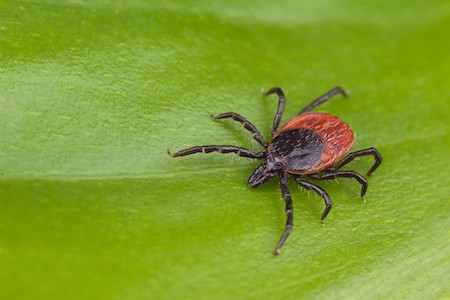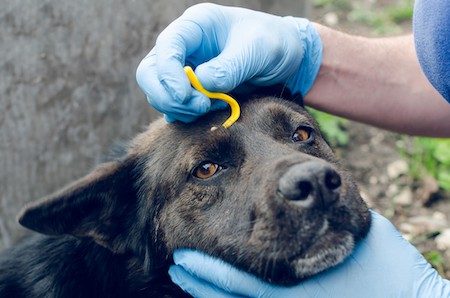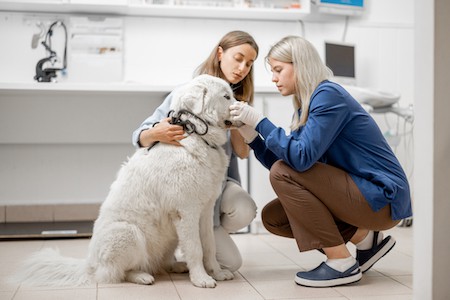Pet Insurance Review > Pet Wellness Guides > How to Protect Your Dog from Lyme Disease - Pet Insurance Review
How to Protect Your Dog from Lyme Disease
Posted: 11/06/2023 | BY: Erin Cain | Categories: Uncategorized
If you’re a dog owner, it’s essential to be aware of Lyme disease and how to protect your pup from it. Lyme disease is caused by bacteria transmitted through the bite of an infected tick. It can lead to serious health problems if not treated early. This article will discuss Lyme disease symptoms in dogs, how to prevent tick bites, and what to do if you think your pup has contracted Lyme disease.

How do dogs get Lyme disease?
The bacteria known as Borrelia burgdorferi is responsible for causing Lyme disease. The infection can be transmitted through a tick bite. Although many ticks can carry this disease, the most common is the deer tick, also known as the black-legged tick. Once the transmission begins, approximately 24 – 48 hours after the tick bites, the disease travels throughout the dog’s body via the bloodstream.
As the weather warms up, it’s prime time for deer ticks lying dormant over winter to become active and potentially transmit Lyme disease. Ticks are known to be active in the fall, early spring, and summer when air temperatures exceed 40 degrees, although they can be found year-round. Thus, annual protection for your dog is a must to reduce the chances that he will contract Lyme disease.
A deer tick is found primarily in forests, tall grassy areas near woods, backyards, and marshy areas near lakes, rivers, and oceans. Many people and pets are bit by ticks when hiking, camping, or playing in their backyards.
There are many areas of the country where Lyme disease is more common, with higher risks for pets. According to the Center for Disease Control (CDC), the states that had the highest incidences of Lyme disease in 2019 include:
- Connecticut
- Delaware
- District of Columbia
- Maine
- Maryland
- Massachusetts
- Minnesota
- New Hampshire
- New Jersey
- New York
- Pennsylvania
- Rhode Island
- Vermont
- Virginia
- West Virginia
- Wisconsin
More minor cases have been reported along the West Coast, with rising incidents in Tennessee, Ohio, and the Carolinas. Even if you live in a state where Lyme disease is not prevalent, your pup can still contract it. To see the occurrences of Lyme disease in American pets for 2022, check out this map.

What are the symptoms of Lyme disease in dogs?
When your dog is bitten by an infected tick, it can take months before you notice any symptoms. Look out for these signs that could indicate Lyme disease in your pup:
- lameness (may shift from one leg to another)
- fever
- joint pain and swelling
- loss of appetite
- lethargy or decreased activity
- depression
- generalized stiffness in the joints and muscles
- sensitivity to touch
- difficulty breathing (a sign of emergency)
- excessive drinking or urination (signs of kidney failure)
Keep an eye out for these symptoms of Lyme disease. If you notice one or more of these signs in your pup, see your veterinarian immediately. They can run a multiplex blood test to determine if your pup has Lyme disease. The good news is there are some ways to treat this disease, although your pup may have long-lasting effects from it for the rest of their life.

What is the treatment for Lyme disease in dogs?
Dogs with Lyme disease may require an antibiotic course that lasts 4 weeks or longer. The antibiotic doxycycline is typically used as the first option for treatment, and it’s an effective way to get rid of bacteria in your dog’s system. Suppose your dog is experiencing a lot of pain. In that case, their veterinarian may prescribe anti-inflammatory medication to help alleviate muscle pain and joint discomfort.
As long as the Lyme disease has been diagnosed and treated early enough, the course of antibiotics will typically resolve signs of the illness within three days. The organism that causes Lyme disease is good at hiding. While treatment typically succeeds in eliminating the clinical signs of the disease, dogs who test positive for it will remain so for years, if not for the rest of their lives. If your pup tests positive but isn’t sick, the vets will tell you whether they think it’s best to treat them.
Sadly, dogs infected by Borrelia burgdorferi Lyme disease often develop severe arthritis. However, the actual “silent killer” is the Lyme organism itself. While its effects on the kidneys may be subtle, Lyme disease can eventually lead to severe complications. Kidney problems are a serious issue that can be fatal if left untreated. Your veterinary team will determine what treatment is best for your pup and monitor the situation closely before renal problems occur.

How can you prevent Lyme disease in dogs?
There are many steps every pup parent can take to prevent their pup from being bitten by infected ticks and suffering from Lyme disease. Here are some prevention tips that can keep our dogs as tick-free as possible:
- Give your dog a parasite preventative: Use a tick preventive product to keep your pet safe from parasites. Speak with the vet about what product will work best for your pup, depending on your pet’s lifestyle.
- Discuss the Lyme disease vaccination with your veterinarian: Research suggests that Lyme bacteria vaccines seem to work well in preventing infection. However, it is still crucial for dogs to take a tick preventive year-round regardless of getting a vaccine.
- Keep your yard clean and neat: To keep ticks away from your backyard, mow the lawn regularly and remove tall weeds or leaf litter around shrubs. Clear tall grasses and brush on and near your yard. Stop parasites from spreading around your property via rodents by securing your outdoor trash cans. Tending to these areas can help make it less attractive for these pesky parasites.
- Avoid walking dogs in tick-prone areas: Wooded paths, marshes, water locations, and trails lined with tall grasses are often home to ticks. Tall grass, brush, and weeds provide the best places for these blood-sucking parasites to climb plants, waiting patiently until they catch an unsuspecting victim. To minimize your contact with ticks, walk in the center of trails through wooded areas or avoid natural areas altogether and stick to sidewalks.
- Check your dog for ticks daily. Before your pup comes indoors, check them carefully for any odd bumps. Thoroughly part the fur until you can see where the coat meets the skin. In particular, check areas these parasites love to frequent, including inside and outside the ears, on the head, underneath the legs, the tail, and around the neck (especially near or underneath the collar).
- Protect yourself, too: Regularly check yourself for ticks after being outside. Use repellent, wear treated clothing, and shower once you enter your home. Ticks can easily hop from you to your pets, so taking these proactive steps protects you and your furkids.
Your pup poses no risk to you or those around them. However, they may carry parasites that could be infected with diseases like Lyme disease or Rocky Mountain Spotted Fever.

How to remove a tick from your dog.
It’s always good practice to ensure your canine companion is tick-free after time spent outdoors. If you notice a tick attached to your pup, don’t touch it with your fingers! Take these steps to remove the tick, then contact your veterinarians for the following steps:
- Grab the tick with fine-tipped tweezers as close to your dog’s skin. Don’t squeeze, as this could release more harmful components of a tick’s saliva into the dog’s body and the Borrelia burgdorferi bacteria.
- Gently but firmly pull the tick straight up to remove any embedded mouth bits. During this process, don’t jerk or twist, as the mouth bits can break off and remain in your pup’s skin. If the mouth breaks off, try to remove it with tweezers, or leave it and let your canine heal.
- Wash the bite area and your hands thoroughly with soap or rubbing alcohol.
- You can dispose of the tick by putting it in alcohol, wrapping it tightly with tape, placing it in a sealed container for disposal later on, or flushing it down the toilet.
Inform your veterinarian about the type of tick you found on your dog. They can identify the tick, determine if it may carry Lyme, and advise you on the signs to look out for in your pup.
Pet insurance is extra protection for your canine companion.
There are a lot of dangers out in the world for our pups, like infected ticks and Lyme disease. Although we do everything we can to protect them, sometimes it’s not enough. That’s when a pet health insurance policy can save the day. With a pet insurance plan, the cost of your dog’s medical emergency treatments will be reimbursed to you by up to 90%, depending on your choice of policy. Protect your pet! Get a free pet insurance quote today, and let Pet Insurance Review find the best plans from top providers for you and your pup.
References:
- American Lyme Disease Foundation. (2022). What is Lyme disease? Retrieved from https://www.aldf.com/
- Kurokawa, C., Lynn, G., Pedra, J., Pal, U., Narasimham, S., Fikrig, E. (2020). Interactions between Borrelia burgdorferi and ticks. Retrieved from https://www.nature.com/articles/s41579-020-0400-5
- Centers for Disease Control and Prevention. (2021). Lyme Disease Maps: Most Recent Year. Retrieved from https://www.cdc.gov/lyme/datasurveillance/maps-recent.html
- Pets & Parasites. (2022). Parasite Prevalence Maps. Retrieved from https://www.petsandparasites.org/parasite-prevalence-maps#/
- Forman, M. (n.d.). A Better Lyme Disease Test Developed at Cornell University. Retrieved from https://www.cuvs.org/blog/better_lyme_disease_test_developed_cornell_university
- Burke, A. (2016). Doxycycline for Dogs: Uses and Side Effects. Retrieved from https://www.akc.org/expert-advice/health/doxycycline-for-dogs/
- Beall, M. (2020). New Study Shows Link Between Ticks and Kidney Disease. Retrieved from https://www.pethealthnetwork.com/dog-health/dog-checkups-preventive-care/new-study-shows-link-between-ticks-and-kidney-disease
- Corsillo, L. (2020). The Very Best Tick Treatments for Dogs. Retrieved from https://nymag.com/strategist/article/best-tick-treatment-for-dogs.html
- Barnette, C. (2021). Lyme Vaccine for Dogs. Retrieved from https://www.greatpetcare.com/pet-vaccinations/lyme-vaccine-for-dogs/
- Clark, M. (2022). Rocky Mountain Spotted Fever in Dogs: Symptoms, Causes, & Treatments. Retrieved from https://dogtime.com/dog-health/56635-rocky-mountain-spotted-fever-dogs-symptoms-causes-treatments
The information contained on this blog is intended for informational and educational purposes only and should not be construed as medical advice. It is not a substitute for professional veterinary care. Always consult with your veterinarian before making any changes to your pet's health care or treatment plan.
The authors of this blog are not veterinarians and do not claim to be experts in pet health. The information provided here is based on our own experiences and research, as well as information from reputable sources. However, we cannot guarantee the accuracy or completeness of this information.
We encourage you to do your own research and consult with your veterinarian before making any decisions about your pet's health.